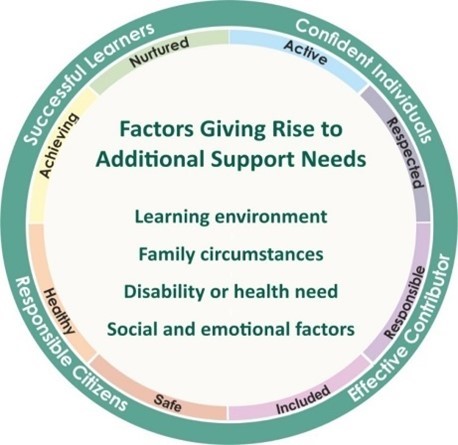1.3. Additional support needs
Legislation is premised on support for all learners beginning within the classroom. It is provided by the classroom teacher who holds the main responsibility for nurturing, educating and meeting the needs of all pupils in their class and, working in partnership with support staff, to plan, deliver and review curriculum programmes. Support for children and young people with dyslexia as well as those who experience literacy difficulties and other additional support needs is achieved through universal support within the staged levels of intervention. This is discussed in further detail in Section 4.
In Scotland pupils who may require additional support under the Education (Additional Support for Learning) (Scotland) Act 2004, as amended, have a barrier to learning as a result of one or more of the four factors giving rise to additional support needs:
- Learning environment
- Family circumstances
- Disability or health need
- Social and emotional factors
‘Additional Support Needs’ is the standard terminology used in Scotland when children and young people need more – or different - support to what is normally provided in schools or pre-schools to children of the same age. Additional support is a broad and inclusive term which applies to children or young people who, for whatever reason, require additional support, long or short term, in order to help them make the most of their school education and to be included fully in their learning. The term ‘additional support needs’ covers a wide range of factors and children or young people may require additional support for a variety of reasons.
The 2020 Independent Review of additional support for learning implementation report highlighted the interconnection between the factors which give rise to additional support needs and that they are
‘not mutually exclusive. This Review heard about increasing numbers of children and young people where issues due to Autism Spectrum Disorder (ASD) are compounded by social, emotional, behavioural problems linked to poverty and inequality’.
It is highly likely that all educational staff will work with and support learners with dyslexia or literacy difficulties at some stage. With this in mind it is important for all staff to have an awareness of their professional duties and legislation with regards to inclusion and an understanding of how to support dyslexia.
Activity 6 Revealed task
Think about your understanding of additional support needs and why children and young people may need some additional support. You may choose to take notes in your Reflective Log.
Click ‘Reveal discussion’ to see a list which highlights that children or young people may require additional support for a variety of reasons. Please note that this list in not exhaustive.
Discussion
These may include those who:
- Have motor or sensory impairment
- Are being bullied
- Are particularly able or talented
- Have experienced a bereavement
- Are interrupted learners
- Have a learning disability
- Are looked after by the local authority
- Have a learning difficulty, such as dyslexia
- Are living with parents who are abusing substances
- Are living with parents who have mental health problems
- Have English as an additional language
- Are not attending school regularly
- Have emotional or social difficulties
- Are on the child protection register
- Are young carers
Or any other reason.
Activity 7
The Education (Additional Support for Learning) (Scotland) Act 2004, as amended, states that a barrier to learning results from one or more of the factors giving rise to additional support needs, otherwise learning is inhibited.
What are the factors which give rise to additional support needs?
Discussion
Options:
Learning environment
Living environment
Family circumstances
Financial difficulties
A disability or health need
A disability
A health need
Social and emotional needs
Social needs
Emotional needs
Social deprivation
Learning activities
Play spaces
1.2. Legislative and policy framework

